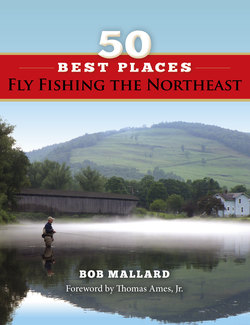Читать книгу 50 Best Places Fly Fishing the Northeast - Bob Mallard - Страница 44
На сайте Литреса книга снята с продажи.
ОглавлениеInset. Guide Kevin Winsor with
male salmon. Weatherby’s
Fall nymphing at the Picnic Pool. Weatherby’s
voraciously on them. White suckers enter the stream for their spawning run soon after the smelt. Salmon follow the suckers and feed heavily on the eggs as they drift in the current. After the spring spawning runs, salmon move upstream and settle into the pools and runs.
By midsummer in most years, the majority of salmon have moved back to West Grand Lake. However, in summers with high water and cool temperatures, the salmon stay in the stream longer—sometimes into August. By mid-September, the days are shorter, air
Fat spring female. Weatherby’s
temperatures drop, and the water cools. This triggers the annual salmon spawning run in the stream. Fall fish are typically much larger and heavier than spring fish, having fed on smelt all summer in the lake. They sport their bright autumn colors, with males displaying the pronounced kype that is typical of spawning salmon.
The later in the fall one fishes, the more fish can be found in the river. This starts in the upper pools, and spreads downstream from there. Fall fishing can be rewarding. However, it can be frustrating as well, as the salmon are not feeding aggressively and begin to exhibit territorial behavior. Many of the fish in the fall will be caught on smelt imitations, as they have been feeding on smelt in the lakes all summer. They will also take large, bright streamers that stimulate territorial strikes. Fish will still feed on caddis, stonefly, and mayfly nymphs. There are also some significant BWO hatches in September and October—if you have trouble hooking up, go smaller.
Hatches: The first hatches begin in mid-May as Hendricksons and March Browns start to appear. This is followed by prolific caddis hatches starting in late May and running well into June. Mid-June to July finds the caddis tapering off, with stoneflies and Sulphurs taking over, followed by Blue-winged Olives into July. In late spring, terrestrials such as flying ants, dragonflies, and hoppers are present.
